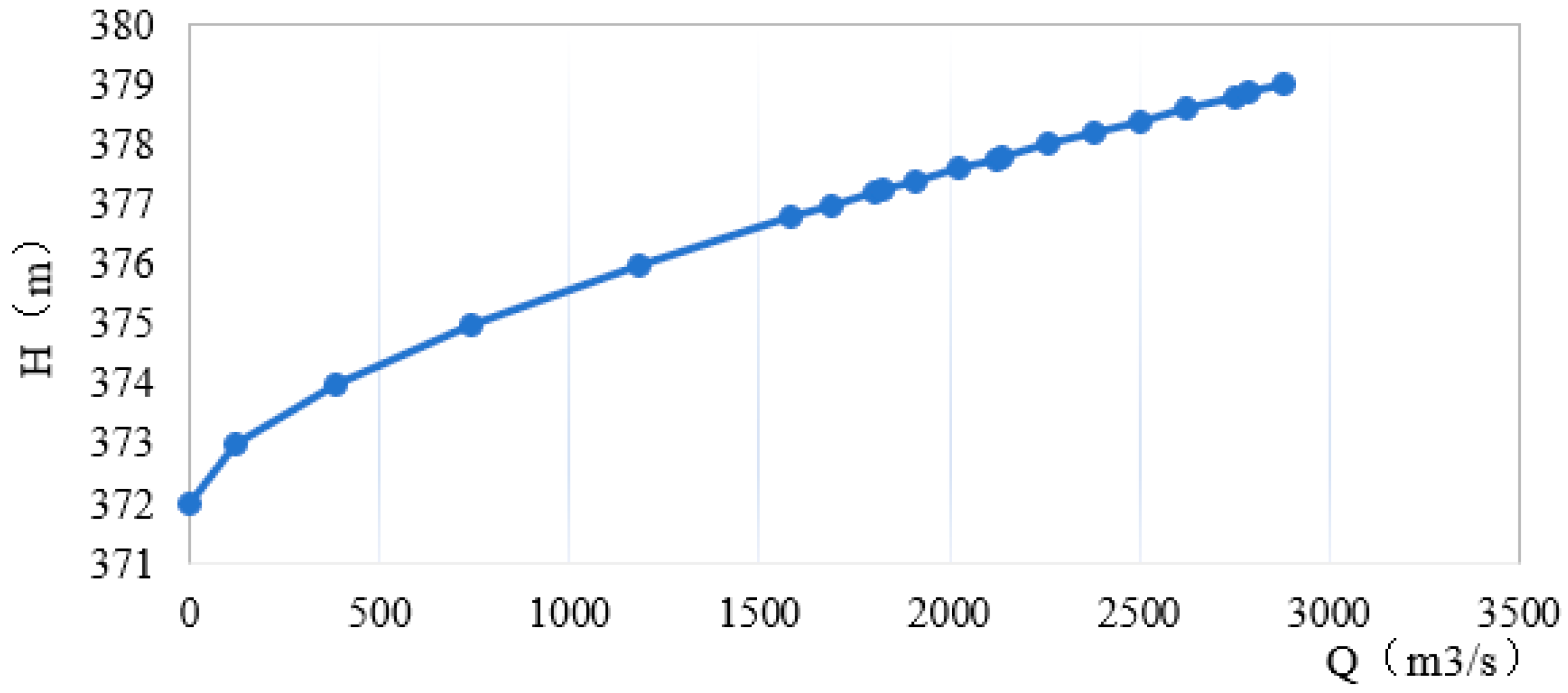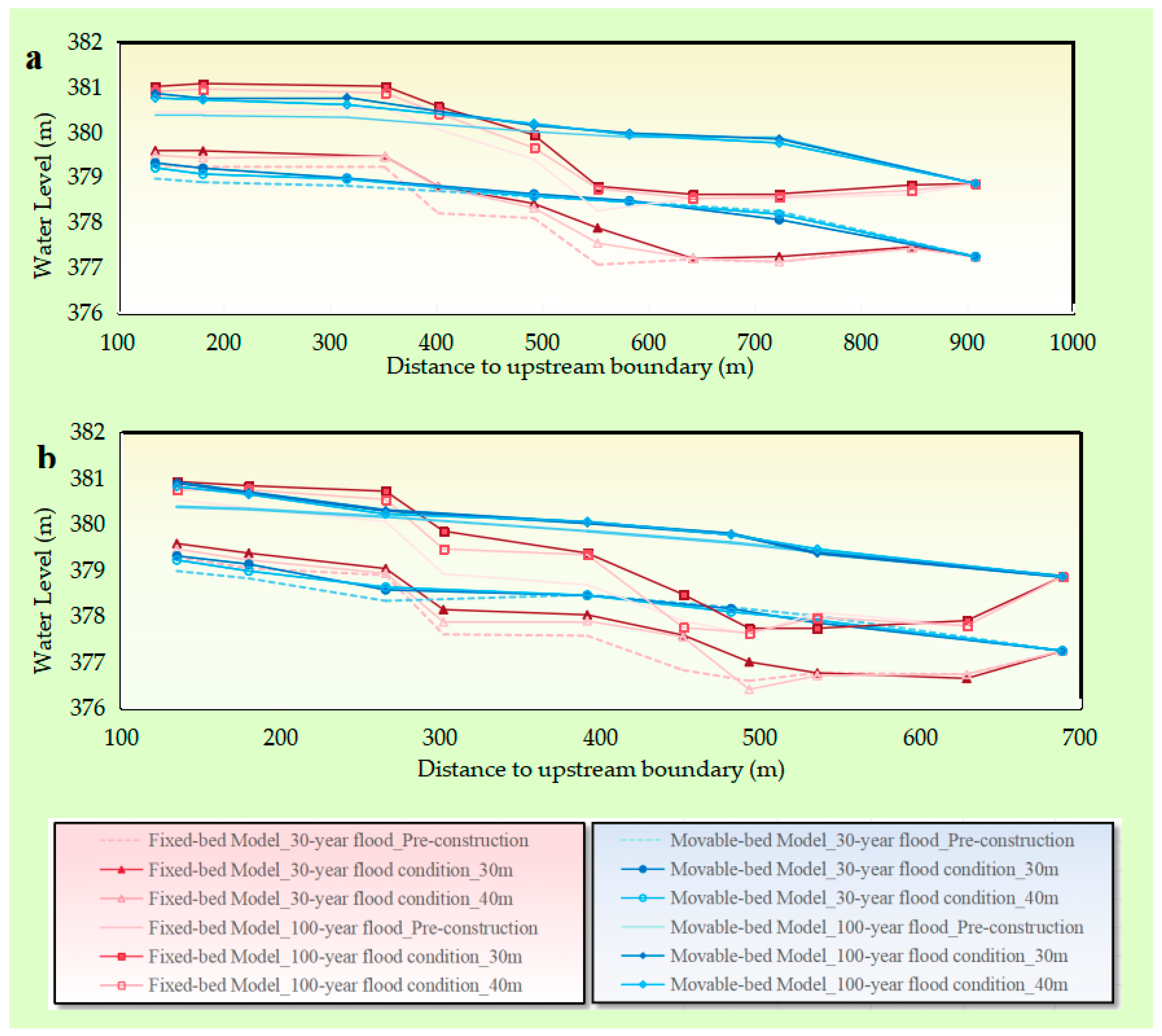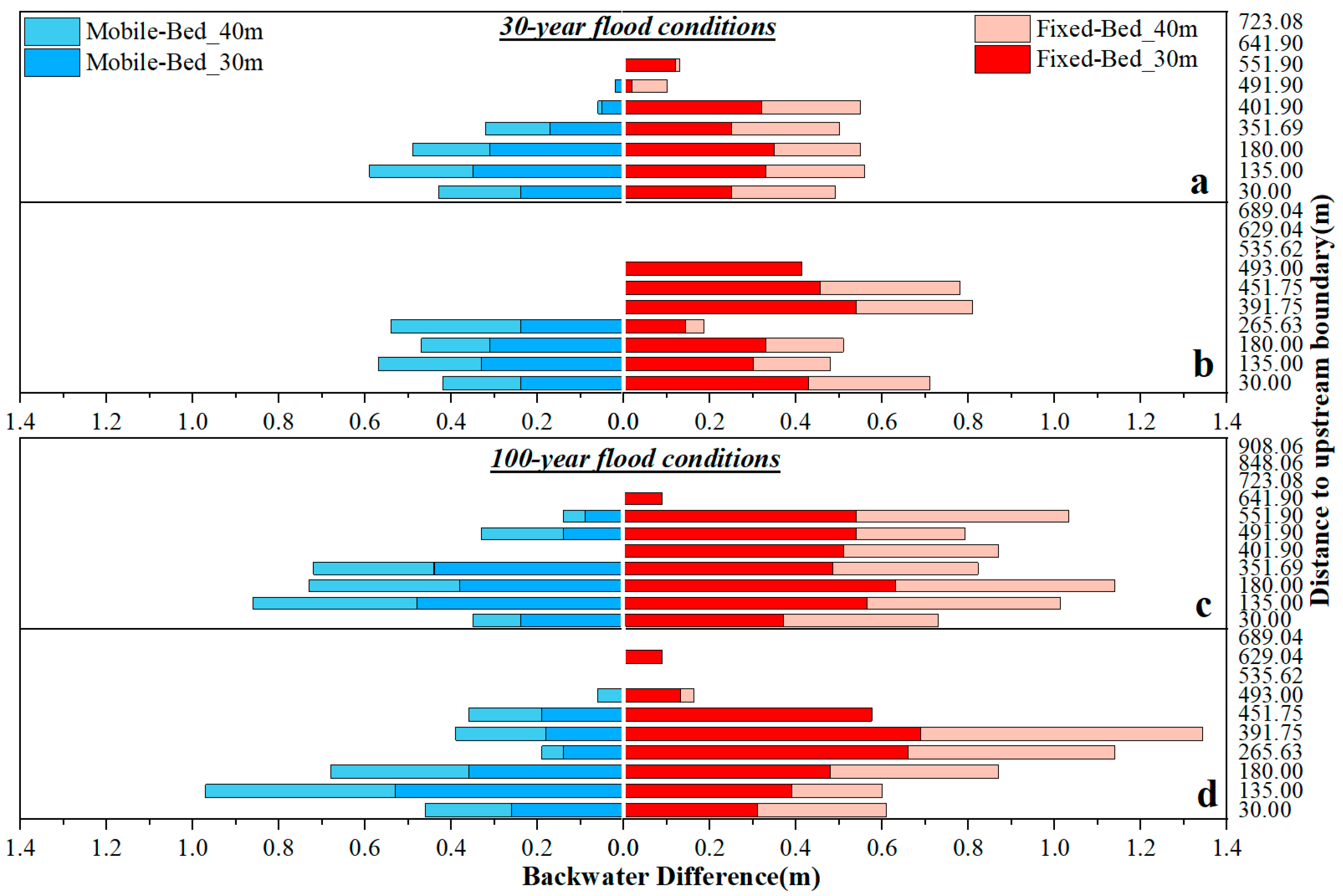1. Introduction
River floods rank among the world’s most severe natural disasters. Flash floods are particularly destructive, causing significant loss of human life and property. However, under the influence of climate change, extreme rainfall events are projected to intensify, leading to more severe flooding [
1]. The construction of river-crossing structures, such as bridges, significantly alters the hydraulic characteristics of rivers, thereby affecting fluvial morphological stability. Newly constructed bridges can elevate upstream water levels, potentially compromising embankments and threatening the safety of riverside communities [
2,
3]. The obstruction effect of bridge piers leads to flow redistribution, upstream backwater, and complex local scour, posing direct threats to the structural safety of the bridges themselves and the flood conveyance capacity of the river reach. Furthermore, vortices and high-velocity flows forming near bridge piers can induce local scouring of the riverbed. Therefore, optimizing pier arrangement to mitigate impacts on river flooding is crucial for both bridge design and flood risk management. Consequently, accurately predicting and mitigating the comprehensive impact of bridge construction on river channels has long been a central topic in hydraulics and river engineering.
Extensive research has been conducted to investigate bridge pier hydraulics using various methods, including numerical simulations and physical modeling. It is widely recognized within the academic community that factors such as pier spacing and pier shape are critical influencing factors. Among these, increasing pier spacing is generally understood to help reduce flow contraction, alleviate upstream backwater, and diminish local scour depth. Current research on river flood hazards primarily involves calculating flood inundation extents for various design frequencies. When hydraulic structures such as bridges or weirs exist within the channel, their flow capacity and backwater extent become critical factors for risk and impact assessment. Existing studies mainly employ empirical formulae to calculate backwater values upstream of bridges [
4,
5,
6], with related theories and empirical approaches being relatively well-established [
7,
8]. Physical scale model testing helps identify the hydraulic impacts of projects during floods and validates the effectiveness of design modifications; the ultimately optimized design ensures the hydraulic transparency of the project. Such models are invaluable tools for optimizing major linear infrastructure crossing floodplains, particularly in areas where flow patterns and hydraulic structure behavior are difficult to ascertain solely through numerical modeling. The numerical modeling of river channels often incorporates a fixed-bed boundary condition. Nevertheless, relatively few investigations have been conducted to quantify the differences in outcomes between movable-bed and fixed-bed scenarios.
Heng et al. emphasized the significant role of physical models in hydraulic engineering and fluvial geomorphology, within which mobile-bed and fixed-bed tests are key components [
9]. Mobile-bed experiments simulate deformable riverbeds where sediment can erode, transport, and deposit under flow action, leading to bedform changes [
10,
11]. The core of these experiments lies in capturing the coupled effects between sediment movement and water flow, making them especially suitable for studying scouring, sedimentation, riverbed evolution, reservoir sediment management, and sediment transport laws [
12,
13,
14]. This capability affords mobile-bed tests unique advantages in river flood control [
15]. Wang Chen conducted experiments investigating local scouring mechanisms in stratified sand with an upper coarse layer, specifically examining the scouring development process under conditions of upper coarse and lower fine sand [
16,
17]. Research on long-distance mobile-bed models of the Yellow River holds practical significance for guiding sediment management in large rivers [
18]. Furthermore, factors such as particle size, shape, and specific gravity significantly influence sediment movement, rendering refined sediment simulation a persistent challenge.
Cantero-Chinchilla et al. utilized fixed-bed experimental data to validate turbulence models for rivers and hydraulic structures [
19]. A major limitation, however, is their inability to simulate morphological changes in the riverbed induced by sediment erosion and deposition [
15], restricting their application to problems involving bed dynamics, such as scouring and sedimentation. Kim and Hwang performed three-dimensional numerical simulations of dam-break waves in an L-shaped channel, comparing water level variations induced by the dam-break wave under both mobile-bed and fixed-bed conditions. Integrating mobile-bed and fixed-bed experiments can yield a more comprehensive understanding of river systems [
20]. For instance, a review by Hamidifar et al. highlighted the role of sediment transport in flood modeling and river dynamics, emphasizing significant differences in water depth and discharge between mobile-bed and fixed-bed conditions [
15].
However, existing studies often focus on a single model type or a specific flood event, lacking a systematic comparative evaluation of the simulation capabilities of different model types (fixed-bed vs. mobile-bed), particularly within the specific engineering context of determining the optimal pier spacing for new bridge constructions. A clear research gap exists in directly linking engineering design choices regarding pier spacing to quantifiable flood control and safety benefits (e.g., flood discharge capacity, scour depth), which is essential for providing dynamic and explicit criteria for engineering decision-making.
Consequently, the model tests concerning the river channel in the present study are conducted within two distinct systems: the fixed sand bed (fixed bed) and the movable sand bed (mobile bed). To address these gaps, this study instituted a comparative physical modeling campaign. The primary objectives were:
- (1)
To evaluate the relative advantages and limitations of fixed-bed and mobile-bed physical models in simulating the flow patterns, velocity variations, and local scour phenomena induced by bridge piers under flood conditions corresponding to 30-year and 100-year return periods.
- (2)
To quantitatively investigate the effect of pier spacing (30 m vs. 40 m) on key hydraulic and morphological responses, including upstream backwater rise, local scour depth, and overall flood conveyance capacity within the studied river reach.
- (3)
To elucidate the underlying mechanisms governing the interaction between flow fields, sediment transport, and riverbed evolution, thereby establishing a hydrodynamic foundation for risk assessment.
2. Experimental Work
2.1. Experimental Apparatus
A proposed bridge project on the Chihe River, a tributary of the Hanjiang River within Shaanxi Province, was selected as a case study (
Figure 1). This reach is characterized by two consecutive bends, with mountainous terrain on one side and a residential area on the other. The flood risk in this area poses potential threats to urban infrastructure and public safety. Furthermore, an existing highway bridge within the same reach necessitates that the physical model experiments also account for the scour effects on in-stream structures.
A physical hydraulic model was constructed to simulate a newly proposed bridge at the river. The model employed a geometric scale ratio of 1:60; prototype river reach length: 1000 m; model length: 18 m; prototype channel width: 80 m; and model width: 1.5 m. An existing highway bridge is located along the left bank, featuring bridge piers spaced at 20 m intervals, each with a diameter of 1.5 m. The proposed bridge features piers spaced at intervals of 30 m and 40 m, with a pier diameter of 1.3 m. Comparative tests were conducted for both the fixed sand bed (fixed bed,
Figure 2) and the movable sand bed (mobile bed) under flood peak discharge conditions (
Table 1) corresponding to 30-year and 100-year return periods.
To ensure flow similarity between the model and prototype water bodies, both the model water depth (hm) and the model flow Reynolds number (Rem) must satisfy the requirements. Natural sand is selected as the model sediment, and since the sediment particle size scale ratio is identical to the geometric scale ratio, the similarity condition for bed roughness (flow resistance) is automatically satisfied.
Based on the bed material gradation and calculations of the incipient motion condition of granular sediment, natural sand can be selected as the model sediment. According to Shamov’s formula for incipient motion of granular sediment, the grain size scale ratio between bedload sediment and bed material can be directly determined.
Since this is an undistorted physical model and natural sand is adopted as the model sediment, the sediment grain size scale ratio is consistent with the geometric scale of the model. Consequently, the similarity condition for bed roughness (resistance) is automatically satisfied. Regarding the roughness of embankment slopes, the governing scale relationship follows λn = λL
1/6= 1.98. Therefore, the roughness of the embankment slopes must be controlled according to this relationship. Consequently, the model roughness coefficient (
n) equals 0.035. The details of all model scale ratios are presented in
Table 2.
The derivation of time scale ratios for sediment transport and bed deformation follows the principles of geometric, kinematic, and dynamic similarity as applied to movable-bed models [
21].
The dry bulk density of naturally deposited bedload sediment was set at 1.6 t/m
3 for the prototype and 1.2 t/m
3 for the model. This results in a scale ratio for dry bulk density of bedload deposits, denoted as
, of approximately 1.33. Based on the similarity conditions for bed deformation due to bedload transport, the time scale for bed evolution similarity was derived as:
It can be observed that the time scale for bed deformation similarity related to bedload transport differs from the hydrodynamic time scale. According to the principles of sediment model design, when these two time scales are not identical, the time scale governing bed deformation should be adopted as the controlling criterion [
22]. Tests were conducted under steady-flow conditions. Flow duration for mobile-bed tests was 5 model hours (48 prototype hours) to achieve equilibrium.
Based on our preliminary geological survey, the gradation of sediment used in this model was determined according to the model scales, as shown in
Table 3. Two types of natural river sand were selected and blended in a specific proportion to prepare the sediment for the experiments. The prototype gradation of the bed material, the theoretical model gradation, and the actual gradation of the blended sediment are presented in
Figure 3.
2.2. Experimental Design
The channel sidewalls of the physical model were constructed using masonry bricks. Both the embankment slopes and the inlet/outlet sections were configured as fixed beds with a cement mortar finish applied to their surfaces. Steeper slopes along both banks within the model channel were also constructed as fixed beds, representing the stone masonry slope protection lining the prototype river banks. The riverbed portion of the model featured a movable layer, formed using model sand to simulate the erodible bed of the prototype channel. The fixed beds were created by applying a surface finish directly over the foundation rock layer according to its elevation, resulting in a rigid sand bed. Within the modeled river reach, both the existing highway bridge and the proposed bridge group (including the bridge piers) were incorporated. The external dimensions of all bridge piers were geometrically scaled down and fabricated from acrylic tubes of identical size. The elevation error during the actual model construction was strictly controlled within 1 mm.
Control sections were established starting from the upstream boundary at measured intervals of 30 m. Additionally, two control sections were added within two river bends. Section CS32 serves as the downstream water level control section, as depicted in
Figure 4. A hydrometric station (HS) is located between CS7 and CS8.
Figure 5 shows a schematic bathymetric cross section of the prototype channel at the bridge site, annotated with the water levels for the 30-year and 100-year flood events. All elevation data presented in the figures and throughout the study use the Yellow Sea Height Datum. The pier of the proposed bridge (Pier 1) is situated downstream of section #9. The specific locations of all sections are detailed in
Table 4.
Measurements commenced after the flow had stabilized for 2 h. Due to the significant difference in flow path length between the left and right banks, the water surface elevations were recorded separately for each bank. Velocity measurements were obtained using a propeller-type current meter (Ouka Instruments Co., Ltd., Nanjing, China), with five to eight measurement points deployed at each cross section. The sampling interval was set to 15 s.The measurement uncertainty for the velocity magnitude, derived from instrument calibration and repeated measurements under stable conditions, is estimated to be ±2%. In fixed-bed tests, the bed was pre-formed. In mobile-bed tests, the local scour depth at each pier location of the highway bridge were measured using a point gauge (Lainde Intelligent Technology Co., Ltd., Shandong, China) and a laser distance sensor (Yachen Instruments and Meters Co., Ltd., Fujian, China) traversing on a movable rack.
2.3. Stage–Discharge Relationship
The downstream boundary water level is determined by the stage–discharge relationship curve at the downstream outlet cross section. The model outlet section was selected at a location characterized by relatively straight local channel alignment and stable cross-sectional geometry. Based on analyses of the low-flow channel slope and the thalweg slope, the design flood slope for this reach was established as 0.003. Considering the riverbed composition, bed surface characteristics, channel bank properties, and planform morphology, a comprehensive analysis determined the channel’s Manning’s roughness coefficient to be 0.035. Accordingly, the stage–discharge relationship at the downstream boundary section was calculated using Manning’s equation:
where Q, n, J, R, and A represent discharge, roughness coefficient, energy slope, hydraulic radius, and cross-sectional flow area, respectively. The resulting relationship curve between the downstream boundary water level and discharge is presented in
Figure 6.
4. Conclusions
To investigate flood-response mechanisms to newly constructed river bridges, we established a 1:60 scale physical model based on an actual engineering case. Comparative analyses of 30-year and 100-year return-period flood propagation were conducted under scenarios with and without the proposed bridge, using both mobile-bed and fixed-bed systems. Through parametric regulation of pier spacing, key flood-routing responses were systematically quantified, including spatial flood-level distributions, flow-velocity field reorganization, and local scouring dynamics at existing bridges. Critically, the study demonstrates that the backwater effect induced by the new bridge fundamentally represents propagation of disturbance waves within the channelized reach, while alterations in the flow-velocity field originate from momentum redistribution and turbulence restructuring caused by pier–flow separation. Collectively, these hydrodynamic modifications significantly influence local scour patterns around bridge piers. Thus, the integrated mobile- and fixed-bed modeling framework establishes a hydrodynamic basis for investigating flood-response mechanisms to newly constructed river bridges. The main conclusions are drawn as follows.
The construction of new bridges significantly alters the flow dynamics structure of river channels, inducing upstream backwater effects whose intensity nonlinearly increases with proximity to the bridge axis. Fixed-bed experiments produce larger backwater rises and more extensive inundation extents while achieving high-fidelity replication of water surface profiles. These experiments cannot capture the dynamic feedback mechanisms present in natural riverbeds. Conversely, mobile-bed experiments better align with natural fluvial conditions by enabling dynamic coupling between bedform evolution and flow hydraulics; this process provides more practically relevant hydrodynamic foundations for flood risk assessment. The fundamental distinction between these methodologies lies in how boundary conditions govern energy dissipation pathways: fixed-bed tests isolate purely hydrodynamic responses, while mobile-bed tests elucidate complex sediment–flow–structure interactions. Thus, these approaches collectively advance a comprehensive understanding of backwater phenomena—fixed-bed modeling elucidates idealized mechanistic principles, whereas mobile-bed simulations reveal realistic system evolution.
The placement of bridge piers significantly disturbs the natural flow continuity within the river channel, thereby reshaping the local flow field structure. The hydraulic contraction effect induced by bridge construction, specifically, the narrowing of the effective flow cross section elevates the maximum flow velocity near the pier groups. Furthermore, when flowing past these obstructions, the spatially asymmetric nature of the flow separation phenomenon often causes systematic deflection of the primary flow path; in this instance, manifesting as a rightward shift towards the bank. Consequently, this flow deflection not only modifies the near-bank flow regime but, more critically, substantially amplifies the hydrodynamic shear stress and scouring potential acting upon the foundation of the right-bank embankment. This intensified scouring poses a significant threat to the embankment’s stability. In contrast, the complex vortex structures and flow stagnation zones formed upstream of the pier groups partially dissipate the kinetic energy of the approaching flow. This dissipation generates a sheltering effect for the foundation of the pre-existing downstream bridge, consequently reducing the local flow velocity and scouring intensity acting upon it. This phenomenon is evidenced by the effective reduction in the maximum scour depth observed at the pre-existing bridge following the new bridge’s construction.
In studies concerning bridge construction across rivers and associated flood risks, numerical simulations are commonly employed, typically assuming a fixed riverbed boundary. However, results from movable-bed experiments, as presented above, show significant discrepancies compared to those under fixed-bed conditions. From the perspective of flood risk assessment and safety considerations, it is imperative to conduct movable-bed physical model experiments. This study has not fully accounted for the influence of unsteady flow dynamics. The study was conducted under steady-flow conditions. The effects of unsteady flood wave propagation were not considered. The model did not incorporate the potential effects of vegetation on flow resistance and bank stability. Although scale effects were minimized through careful design, they may still influence very small-scale turbulent structures and extreme local scour phenomena. Given the highly complex and variable terrain, future research should consequently incorporate experimental investigations using representative and critical flood events. The mechanisms revealed in this study can provide critical insights for the preliminary design and risk assessment of new bridges. Such targeted studies would thereby enable enhanced scientific and technical guidance for practical engineering projects.




















